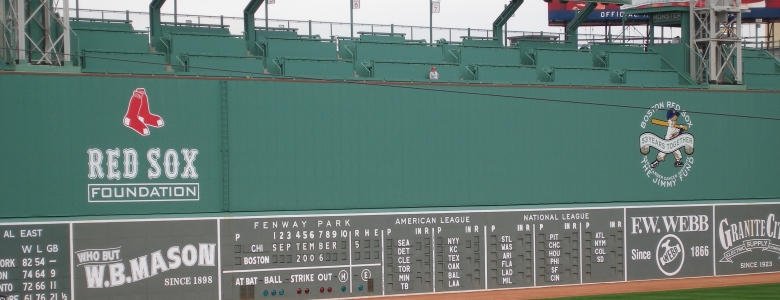Over the years, the generality of “pitching in the AL East” has been formed. While this is partially due to the division’s normally competitive teams, the commonality also stems from the hitter-friendliness of the division’s parks.
Four out of the five parks grade as hitter-friendly (using Fangraphs’ 5-year park factors), with the exception of Tropicana Field (Tampa Bay). The Jays have their Rogers “homer” Centre, the Yankees have a little-league-calibre right field porch, Camden Yards in Baltimore also helps run scoring, as does Fenway Park’s 37-foot high, 231-foot long Green Monster. So, for example, when we hear Rick Porcello is headed to Boston, that only means trouble, right?
I am going to leave out the groundball discussion that I may have opened here. Focusing on Fenway Park itself, its park factor is not black and white. (For a quick understanding of park factors, they are scaled to 100, so a 102 score implies run scoring is 2% above average in the park, whereas a 95 means run scoring is 5% less than average). These are the most extreme park factors as at 2014:
Most Extreme Parks – 2014 | ||||
| Team | Park Factor | Team | Park Factor | |
| Rockies | 117 | Giants | 93 | |
| Rangers | 106 | Padres | 94 | |
| Red Sox | 104 | Mets | 95 | |
You are most likely aware of the effects of the Green Monster. With a wall of that shallowness in left field (310 feet to the left field foul pole), it is easily the shortest of all parks – the next shortest is Tropicana Field at 315 feet, though the average in left field is around 330 feet. In short, if you can hit a ball slightly over 310 feet, you essentially have a double. BABIP, for that reason, is significantly higher to left field in Fenway as well, and the overall park factor in Fenway is 104 (4% higher than average). If you think that park factor seems low considering the Monster effects, you have reason to wonder, as I did.
Let me now describe a different outfield. Visualize a foul pole 302 feet away, the shortest right field line in all of baseball – 12 feet shorter than Yankee Stadium’s. In fact, Johnny Pesky, whom the foul pole is named after, has been quoted as estimating it to be around 295 feet. Being a slap hitter in the mid-1900s, he hit just 17 home runs over his entire career – the concept being that even the weakest power could get the ball over the wall in the corner. The wall itself is less than 6-feet tall, though a significant portion near the bullpen is 3-feet tall.
From the initial facts I displayed in a manipulative way, we have an extremely short corner and a wall that is lower than almost every major leaguer is tall — especially Torii Hunter in the 2013 ALCS. However, a common misconception is that, without an overhaul of knowledge of the entire area’s dimensions, the right field of Fenway Park should be similarly hitter-friendly (at least for home runs). This is not the case at all. For left-handed hitters whom we know generally pull the ball in the air, the park factor is 90 (10% below average). For perspective, only San Francisco, Miami and Oakland are as tough on left-handed hitters for homers – all of which are serious pitcher parks. If you want to argue center field may proportionally cause problems for lefties, dead center field is 390 feet deep (the shallowest in the MLB).
Thankfully, there is a simple reason for the mystery. While the Green Monster may seem like baseball oddest stadium element, Pesky’s pole and right field might be weirder, as visible in the image below.

This may be the oddest looking park in the majors, and perhaps in all of professional baseball. You can see the egregious extension the wall has after the foul pole, as the alley in right field, which peaks at 380 feet of depth (~80 feet further than Pesky’s pole) is the deepest in all of baseball. I would speculate that lefties who cannot pull the ball over the wall probably have little power as is. Good luck to those who try to go the other way to left.
Let’s assume Rick Porcello doesn’t have extreme ground ball rates, for the sake of a generalization. Sure, the monster will turn a lot of those fly balls turning into doubles. That hurts. Yet in measuring long balls, there is no doubt that pull lefties have trouble, as do push righties. For a hitter instance, Pablo Sandoval should have a nice 2015 in Boston, but I am not touching his 18 homer Steamer projection. I admittedly often overvalue park changes, and how they impact the new player in their new home. In Beantown, nobody should be regressing back low home run rates for pitchers, or jacking up homer numbers for hitters. The Green Monster does funny things, but that is not the only extremity of the 100-year-old Boston home.
Next post: Better Know a Prospect: Magneuris SierraPrevious post: The Transition from Playing to Coaching





Chris Dube
Fenway takes away as much as it gives. Homers everywhere else on the planet are often singles or doubles if they are not hit at least 37 feet high.
To listen to most analysts, you would swear Fenway has a run factor about 125 rather than the actual 104.